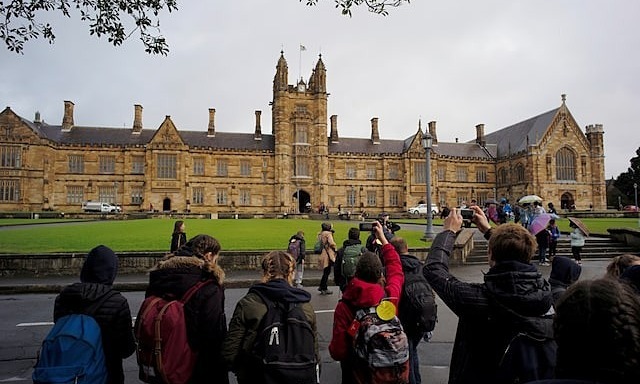Australia adopts new visa rule after plan to cap international student numbers rejected
Visitors take pictures of the main building at the University of Sydney in Australia. Photo by Reuters
The Australian government has introduced a new visa rule to manage international student numbers by slowing down visa processing once universities reach a predetermined target.
This move follows the rejection of a proposal to cap international student enrollments.
The Ministerial Direction 111 (MD111), effective Thursday, establishes two categories for student visa processing: “high priority” and “standard priority.”
Universities will receive expedited visa approvals until 80% of their allocated international student target is reached. After this threshold, visa processing times will be slowed.
A previous proposal to cap international student enrollments at 270,000 by imposing limits on individual institutions was rejected by Parliament.
Finance Minister Katy Gallagher explained to ABC News: “The ministers have looked at other ways to manage the incoming student numbers in a way that we can best meet the needs of the universities but also the numbers of people arriving in Australia.”
Education Minister Jason Clare stated on Thursday that visa applications will now prioritize universities and colleges deemed “sustainable,” according to Bloomberg.
The Australian government announced in May it wants to cap international student numbers to “support the integrity and sustainability of the international education sector.”
It said the cap would allow the education minister to allocate a maximum number of new international student enrollments for institutions.
Australia has consistently tightened regulations for international students since last year amid rising immigration pressures, particularly on the housing market. The government has increased financial proof requirements twice, raised English language proficiency standards, and introduced the Genuine Student Test to ensure visas are used for educational purposes.
Universities have also been categorized into three risk levels based on their admissions. Institutions in levels 2 and 3 experience slower visa processing compared to those in level 1.
Despite these stricter measures, international education remains a key contributor to Australia’s economy, generating US$47.8 billion in 2023, according to government data.
However, the number of international students arriving in Australia has decreased. The Australian Bureau of Statistics (ABS) recently reported 207,000 international student arrivals in 2023-2024, a significant drop from 278,000 in the previous year.


Comments are closed.